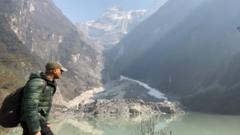Himalayas, one of the world's most iconic mountain ranges, are increasingly getting harder to see due to severe air pollution. Visitors and locals in Nepal’s capital, Kathmandu, are finding it increasingly difficult to catch glimpses of these towering peaks. Haze, caused by pollutants like dust and smoke, particularly during the dry season, is obscuring views that were once celebrated during spring and autumn, now traditionally prime times for clear skies.
A recent flight into Kathmandu had to circle the airport multiple times due to visibility issues caused by haze, and efforts to regain visibility from popular vantage points are often met with disappointment. Yogendra Shakya, a hotel owner in the Nagarkot region, shared how he has had to rebrand his business away from the allure of Himalayan views, which are becoming less reliable.
The situation has been challenging for the trekking industry, with reports of a 40% decrease in business due to hazy conditions. Trekkers are feeling let down, comparing their experiences unfavorably to visits a decade ago. Lucky Chhetri, a trekking guide, expressed the dire situation where guides are unable to provide the mountain experiences promised to tourists, leading to compensation claims.
The haze, described to result from increasing pollution in South Asian cities, is now prevalent year-round, caused by vehicular emissions, construction dust, and agricultural burning. This has led to a record number of hazy days in key tourist areas, leaving many questioning if such scenic views will soon only be available via photographs or postcards. As the haze persists, tourists and trekking operators alike are left hoping for clearer skies.



















